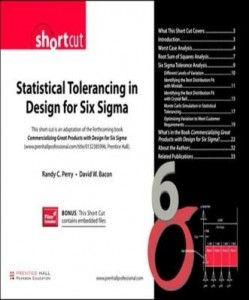This is the eBook version of the printed book. Development of a new product requires the product development team to address many complex customer requirements during the commercialization process. Consider a situation in which a new product being developed must meet specified upper and lower specification limits based on Voice of the Customer interviews. The design team must model and understand the sources of potential variation in the new product that need to be monitored and controlled if the product is to meet the identified customer needs. The process of analyzing component variation and designing a final product that meets customer tolerance requirements is known as statistical tolerancing. In this Short Cut, various Design for Six Sigma techniques for determining the impact of multiple sources of variation on a final product are examined in detail. A procedure is described for using representative models for individual product components to estimate the expected overall level of variation in the performance of a final product. Three methods of tolerance analysis are presented and the merits of each are discussed: Worst Case Analysis, Root Sum of Squares Analysis, and Six Sigma Tolerance Analysis. A detailed case study example, involving multiple sources of variation, is employed to illustrate the application of these methods. Minitab® is used to identify the best-fitting distributions from data sets for individual components. Monte Carlo Simulation with Crystal Ball® is then employed to determine the most important individual sources of variation and the overall variation of the final product. Finally, Crystal Ball's OptQuest® optimization feature is utilized to determine the required design value for each key parameter to meet final customer requirements. Contents What This Short Cut Covers Introduction Worst Case Analysis Root Sum of Squares Analysis Six Sigma Tolerance Analysis What's in the Book Commercializing Great Products with Design for Six Sigma About the Authors Related Publications
Statistical Tolerancing in Design for Six Sigma (Digital Short Cut)
Sobre
Talvez você seja redirecionado para outro site












